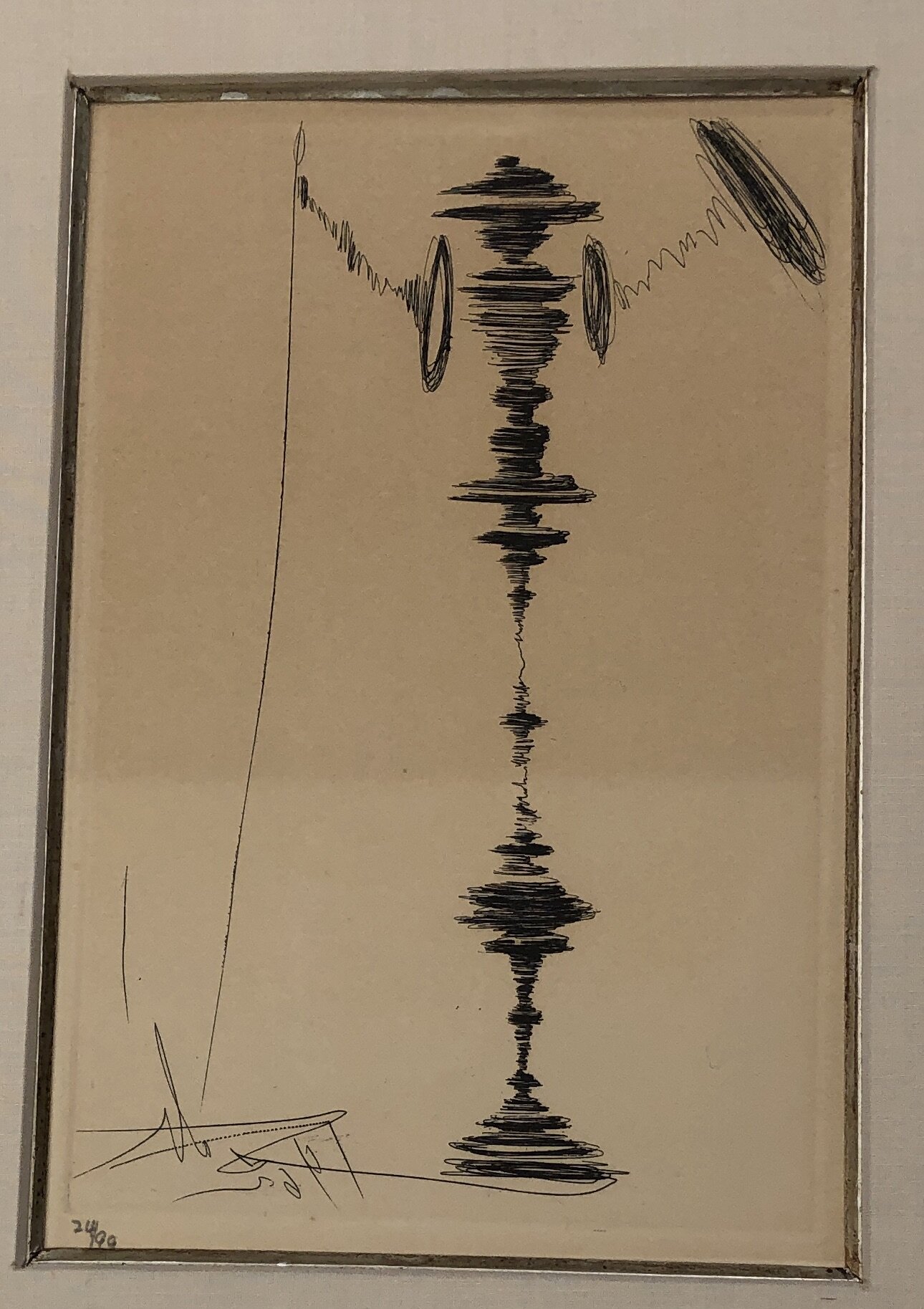Salvador Dalí
Spanish
1904-1989
Deux Fatrasies
1963
Arches Paper
I was first drawn to Salvador Dalí’s Deux Fatrasies, a collection of sketches compiled by Robert Vallette, through one drawing in particular: a tall figure, which primarily consists of an oscillating central line, flanked by two smaller, lighter objects positioned at an angle [Lockport]. From the end of one of these flanking objects sways a single, thin, trailing pencil line which sprawls along the drawing’s base like a mess of string. This line, in turn, lays along the base of the main figure. To me, this central figure was reminiscent of the amplitude signature of a sound, or perhaps a seismograph. As such, I sought to recreate this oscillating central line through the medium of sound.
To create a sound incorporating the shape of Dalí’s line, I used the audio editing software Audacity to trace a single tone into an amplitude signature. I chose to create the sound at a frequency of 440 Hertz; the tuning standard for the musical note A above middle C. This decision reinforces the subjective reality behind a task such as transcribing art between mediums. The vast majority of sounds do not consist of only one frequency, and it would be impossible to recreate the line through audio in a completely objective manner without whimsically assigning it a source. Indeed, there are many personal fingerprints left on the audio file. The scaling and distance of certain line segments are not perfectly matched, and the amplitude signature on Audacity is perfectly symmetrical in a way Dalí’s hand-drawn sketch could not physically be. However, I believe that these differences help capture the nature of such a sketch. If the central figure in this Deux Fatrasies sketch is inspired by a sound, Dalí did not record its signature in a completely objective manner; therefore, no inherent meaning is lost by means of this subjective transcription.
DalÍ was famous for incorporating aspects of psychoanalysis and scientific themes into his artwork; therefore, I believe it is potentially fruitful to analyze Deux Fatrasies through the lens of audio in this regard [Jones, Philadelphia, Wullschläger]. However, I am wary of assigning meaning to Dalí’s sketch by way of my audio interpretation, and instead prefer to present this audio file as an alternate and coexistent method of engaging with Dalí’s work. I hope that my work, along with the cited references, allows for the further analysis and cross-medium characterization of Dalí’s work.
Ero interessato ad un disegno in particolare in Deux Fatrasies, un libro di disegni compilato da Robert Vallette [Lockport]. Il disegno è composto da una figura centrale, costituita principalmente da una linea centrale e oscillante e affiancato da due altri oggetti più piccoli in un angolo. Dalla fine di tali oggetti, una singola, ondeggiante linea si arriccia lungo la base della figura principale. Questa figura principale mi ha ricordato l’ampiezza di un suono visualizzato, o magari un sismografo. Ho voluto ricreare questa linea centrale e oscillante attraverso il medium sonoro.
Per questo progetto, ho usato il software Audacity per modificare un tono singolo e renderlo un’ampiezza sonora. Ho deciso di creare il suono a un frequenza di 440 Hertz. Questa decisione mostra la natura soggettiva della trascrizione dell’arte. La maggior parte dei suoni non hanno un singola frequenza, dunque non posso assegnare una frequenza oggettivamente. Ci sono molte tracce personali nell’ audio: l'audio e il disegno non sono riflessi perfetti, e l'audio è simmetrico in una maniera che il disegno può solo approssimare. Penso che queste differenze catturino la natura di un disegno in un taccuino: d’altronde Dalí non pone l’accento sull’estrema precisione nel disegno.
Dalí ha incorporato psicoanalisi e temi scientifici nella sua arte; a causa di questo, penso che possiamo analizzare Deux Fatrasies fra la prospettiva dell’audio [Jones, Philadelphia, Wullschläger]. Tuttavia, voglio essere prudente a non assegnare significato al disegno di Dalì con la mia interpretazione, e preferisco presentarlo come un metodo alternativo e partecipativo al lavoro di Dalì. Spero che il mio lavoro, con le mie citazioni, offra un’ulteriore analisi e caratterizzazione fra gli strumenti diversi disponibili per leggere Dalì.
Ho utilizzato i servizi di Peer Tutoring di Haverford per la mia grammatica italiana.
References
Lockport St. Gallery. Salvador Dali - Deux Fatrasies or Two Farragoes. https://www.lockportstreetgallery.com/dali/salvador-dali-deux-fatrasies/. Accessed 6 Mar. 2020.
Salvador Dalí: Biography. Philadelphia Museum of Art, https://www.philamuseum.org/micro_sites/exhibitions/dali/downloads/edu/biography.pdf
Jones, Josh, et al. “When Salvador Dali Met Sigmund Freud, and Changed Freud’s Mind About Surrealism (1938).” Open Culture. www.openculture.com, http://www.openculture.com/2020/01/when-salvador-dali-met-sigmund-freud-1938.html. Accessed 29 Apr. 2020.
Wullschläger, Jackie. “Analyse This: Freud, Dalí and the Surrealists | Financial Times.” Ft.Com, 11 Jan. 2019, https://www.ft.com/content/f307b700-0e7c-11e9-a3aa-118c761d2745.

